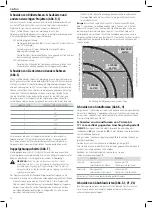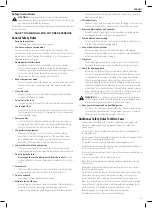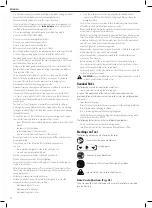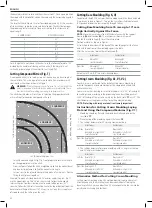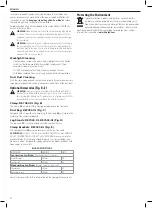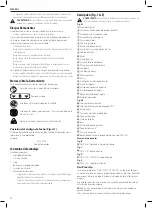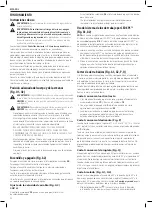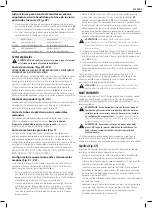
39
EnGLISh
Basic Saw Cuts (Fig. A1, A2, P, Q)
If the slide feature is not used, ensure the saw head is pushed back as far
as possible and the rail lock knob
7
is tightened. This will prevent the saw
from sliding along its rails as the workpiece is engaged.
Cutting of multiple pieces is not recommended but can be done safely by
ensuring that each piece is held firmly against the table and fence.
Straight Vertical Crosscut
1. Set and lock the mitre arm at zero, and hold the wood firmly on the
table
17
and against the fence
14
.
2. With the rail lock knob
7
tightened, turn on the saw by squeezing the
trigger switch
24
.
3. When the saw comes up to speed, lower the arm smoothly and slowly
to cut through the wood. Let the blade come to a full stop before
raising arm.
Sliding Crosscut (Fig. P)
When cutting anything larger than a 51 x 150 mm (51 x 105 mm at
45° mitre) workpiece, use an out-down-back motion with the rail lock knob
7
loosened.
Pull the saw out toward you, lower the saw head down toward the
workpiece, and slowly push the saw back to complete the cut.
Do not allow the saw to contact the top of the workpiece while pulling out.
The saw may run toward you, possibly causing personal injury or damage
to the workpiece.
Mitre Crosscut (Fig. Q)
The mitre angle is often 45° for making corners, but can be set anywhere
from zero to 50° left or 60° right. Proceed as for a straight vertical crosscut.
When performing a mitre cut on workpieces wider than 51 x 105 mm that
are shorter in length, always place the longer side against the fence.
Bevel Cut (Fig. A1, A2)
Bevel angles can be set from 49° right to 49° left and can be cut with the
mitre arm set between 50° left or 60° right. Refer to the
Features and
Controls
section for detailed instructions on the bevel system.
1. Loosen the bevel lock
31
, and move the saw to the left or right as
desired. It is necessary to move the fence
14
to allow clearance.
Tighten the fence adjustment knob
13
after positioning the fences.
2. Tighten the bevel lock firmly.
At some extreme angles, the right or left side fence might have to be
removed. Refer to
Fence Adjustment
in the
Adjustments
section for
important information on adjusting the fences for certain bevel cuts.
To remove the left or right fence, unscrew the fence adjustment knob
13
several turns and slide the fence out.
Grooving (Fig. A2)
Your saw is equipped with a grooving stop
28
, depth adjustment screw
27
and wing nut
26
to allow for groove cutting.
• Flip the grooving stop
28
towards the front of the saw.
• Adjust the wing nut
26
and depth adjustment screw
27
to set the
depth of the groove cut.
• Place a piece of scrap material of approx. 5 cm between fence and
workpiece in order to perform a straight groove cut.
Quality of Cut
The smoothness of any cut depends on a number of variables, such as the
material being cut, blade type, blade sharpness and rate of cut.
When smoothest cuts are desired for molding and other precision work, a
sharp (60 tooth carbide) blade and a slower, even cutting rate will produce
the desired results.
WARNING:
Ensure that the material does not move or creep while
cutting; clamp it securely in place. Always let the blade come to a full
stop before raising arm. If small fibers of wood still split out at the rear
of the workpiece, stick a piece of masking tape on the wood where
the cut will be made. Saw through the tape and carefully remove tape
when finished.
Clamping the Workpiece (Fig. B)
WARNING:
A workpiece that is clamped, balanced and secure
before a cut may become unbalanced after a cut is completed. An
unbalanced load may tip the saw or anything the saw is attached to,
such as a table or workbench. When making a cut that may become
unbalanced, properly support the workpiece and ensure the saw is
firmly bolted to a stable surface. Personal injury may occur.
WARNING:
The clamp foot must remain clamped above the base of
the saw whenever the clamp is used. Always clamp the workpiece to
the base of the saw – not to any other part of the work area. Ensure
the clamp foot is not clamped on the edge of the base of the saw.
CAUTION:
Always use a work clamp to maintain control and reduce
the risk of personal injury and workpiece damage.
Use the material clamp
35
provided with your saw. The left or right fence
will slide from side to side to aid in clamping. Other aids such as spring
clamps, bar clamps or C-clamps may be appropriate for certain sizes and
shapes of material.
To Install Clamp
1. Insert it into the hole behind the fence. The clamp should be facing
toward the back of the mitre saw. The groove on the clamp rod should
be fully inserted into the base. Ensure this groove is fully inserted into
the base of the mitre saw. If the groove is visible, the clamp will not
be secure.
2. Rotate the clamp 180° toward the front of the mitre saw.
3. Loosen the knob to adjust the clamp up or down, then use the fine
adjust knob to firmly clamp the workpiece.
nOTE:
Place the clamp on the opposite side of the base when beveling.
ALWAYS MAKE DRY RUNS (UNPOWERED) BEFORE FINISH CUTS TO CHECK
THE PATH OF THE BLADE. ENSURE THE CLAMP DOES NOT INTERFERE WITH
THE ACTION OF THE SAW OR GUARDS.
Support for Long Pieces (Fig. D)
ALWAYS SUPPORT LONG PIECES.
For best results, use the DE7023-XJ or DE7033 leg stands
37
to extend the
table width of your saw. Support long workpieces using any convenient
means such as sawhorses or similar devices to keep the ends from
dropping.
Cutting Picture Frames, Shadow Boxes And Other
Four-Sided Projects (Fig. R, S)
Try a few simple projects using scrap wood until you develop a “feel” for
your saw. Your saw is the perfect tool for mitring corners like the one shown
in Figure R.
Sketch 1 in Figure S shows a joint made with the bevel adjustment method.
The joint shown can be made using either method.
• Using bevel adjustment:
-
The bevel for the two boards is adjusted to 45° each, producing a
90° corner.
-
The mitre arm is locked in the zero position and the bevel
adjustment is locked at 45°.
-
The wood is positioned with the broad flat side against the table
and the narrow edge against the fence.
• Using mitre adjustment:
-
The same cut can be made by mitring right and left with the broad
surface against the fence.
Cutting Trim Molding and Other Frames
(Fig. S)
Sketch 2 in figure S shows a joint made by setting the mitre arm at 45° to
mitre the two boards to form a 90° corner. To make this type of joint, set
Summary of Contents for DWS779
Page 1: ...Final Page Size 172 x 240 mm DWS779 DWS780 ...
Page 4: ...2 Fig D Fig C Fig B Fig E Fig G1 Fig F 2 1 35 37 36 38 ...
Page 6: ...4 Fig N Fig O1 Fig O2 Fig L Fig M Fig K 73 mm 21 21 55 56 58 59 7 ...
Page 7: ...5 Fig Q Fig S Fig P Fig T Fig U 2 Fig R 1 A ...
Page 8: ...6 Fig X1 ss Fig X2 Fig W1 Fig W2 Fig V2 Fig V1 42 14 14 42 14 17 17 14 ...
Page 9: ...7 Fig Y Fig Z1 Fig Z2 15 1 15 13 57 ...
Page 162: ......
Page 163: ......




